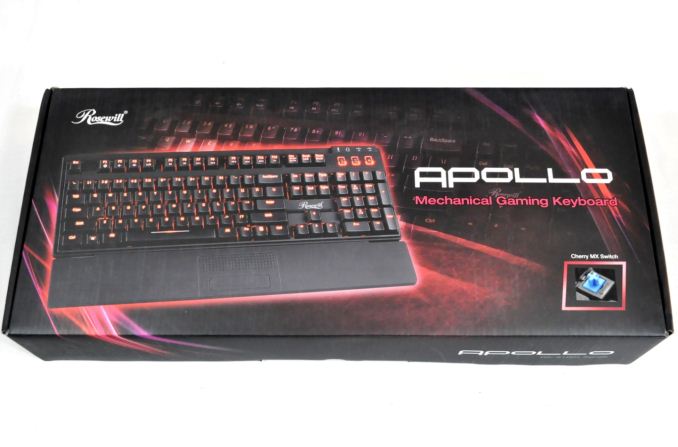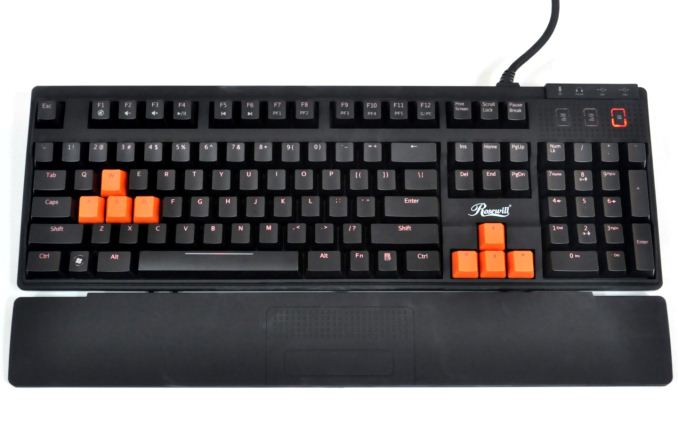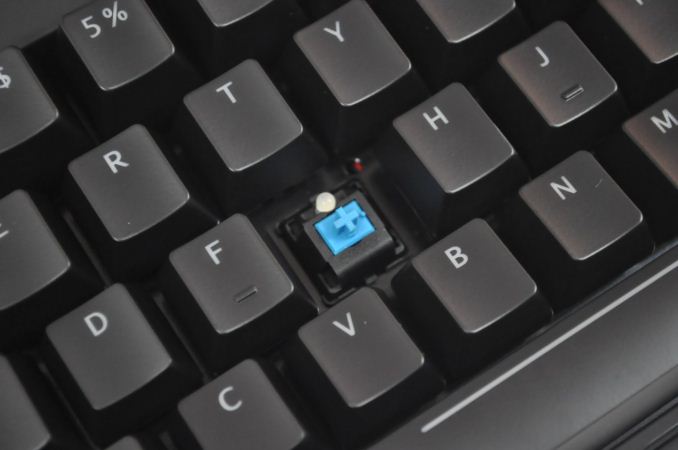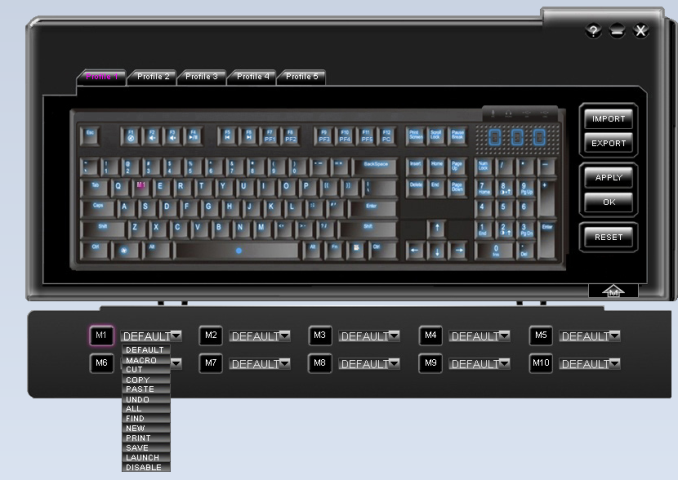Rosewill Apollo RK-9100 & RGB80 Mechanical Keyboards Capsule Review
by E. Fylladitakis on September 16, 2014 9:00 AM ESTRosewill Apollo RK-9100
The Rosewill Apollo RK-9100 is clearly the successor of the very popular Rosewill RK-9000 series. There are several versions of the RK-9100 available, varying by the type of the mechanical switch and the backlighting color. We received the RK-9100xR, the version with the Cherry MX Blue switches and red backlighting.
Aesthetically, the Apollo RK-9100xR looks almost like a standard old-school 104-key keyboard. Only the company logo and the design of the notification LEDs on the right side make a visual difference when the keyboard is powered down. This changes once the keyboard is connected to a system, bringing the backlighting on.
The backlighting is very well applied, illuminating the keycap characters without spilling out from the sides. There is only one slight exception, the spacebar key, where the LED light is focused at the center of the strip and unable to fill it with uniform light. Rosewill also provides two sets of four orange "gaming" keycaps, one for the arrow keys and one for the WASD keys. The orange keycaps are semi-transparent, allowing the LED to illuminate them entirely.
The chassis and the wrist rest of the RK-9100 are both made of corona-treated plastic, which gives a soft, rubber-like feeling to the touch and does not get dirty too easily. It is a relatively thin mechanical keyboard, as the chassis of most similar designs is nearly twice as thick. Two USB ports and audio jacks can be found conveniently placed at the top-right side of the keyboard. The two USB 2.0 ports are very close to each other however, and devices wider than a standard USB connector (e.g. certain flash drives) may be obstructed if either port is already populated. Furthermore, these two USB ports are not powerful enough to power devices such as external 2.5" mechanical disk drives.
As promised, the mechanical switches of the Apollo RK-9100 are Cherry MX Blue. The keys are firm, feeling very solid and consistent, even though Rosewill is using bar stabilizers instead of cross stabilizers beneath the longer keys. Under the hood, we found a very well assembled board, without soldering imperfections or mechanically weak links. A Freescale MC9S08JM16 microcontroller lies at the heart of the system, with a larger Genesys Logic GL850G USB 2.0 hub controller next to it.
By holding down the FN key, the F-keys offer additional functions. F1 to F6 keys perform sound and media control functions, while F7 to F11 keys will switch between the five different programmed profiles. FN+F12 will enable or disable "Gaming mode", disabling the windows key and initiating the gaming profiles. Finally, the FN plus the up/down arrow keys controls the backlighting settings.
The greatest feature and the weakest link of the Apollo RK-9100 is that the keyboard is fully programmable. You can literally program any key to perform any action at all, from simple layout changes to actuating macros. You can program up to fifty macros (ten per profile), with each macro being capable of registering up to 27 keystrokes.
Limiting each profile to ten macros is a bit odd as well; while it's doubtful most users would actually need 50 macros on a single profile, there are certainly some that will want more than ten. As usual, there are software packages that provide a better macro experience if that's what you need, but the built-in macro support does travel with the keyboard.
While the provided macro programming software does work and has a simple interface, it really kills the potential of the keyboard. The interface looks as if it came from a 1980s Windows 3.11 machine and really needs an update. As this is one of the main new features of the RK-9100 over the previous generation RK-9000, if you don't need macro support you can save $20 or more by sticking with the tried-and-true RK-9000 series.




















20 Comments
View All Comments
Spoogie - Wednesday, September 17, 2014 - link
Someone serious about a mechanical keyboard and spending this kind of coin will hardly find this few tedious. The author was remiss. Get over it.E.Fyll - Thursday, September 18, 2014 - link
My apologies but I really fail to realize your logic. If the keys, backlight colors, macro options, prices, and warranties are "minor differences", then the RK-9100 is "identical" to about 100 keyboards sold worldwide.I have zero experience with Monoprice products, they are no even being sold on this side of the planet. However, by your post, it is a similarly priced keyboard with different switches and no programmability (which means that it has an entirely different processor to begin with). It is not nearly the same thing, even if it looks similar.
Furthermore, if I were to look around, I bet that I could find visually similar keyboards under at least 10 brand names. Do you think that there are no similar products in China, Russia or France? Many companies are using the same OEM, not just Rosewill and Monoprice. Requesting to recite every single keyboard that simply looks like another in a capsule review is somewhat...useless.
Spoogie - Friday, September 19, 2014 - link
The keyboards aren't just "visually similar." Scroll up. Their innards are identical.And since Monoprice isn't sold worldwide, I guess this info shouldn't be posted for the millions of North Americans that would benefit. And never mind that several other brands were posted.
Good grief. Get a grip already.
jonjonjonj - Thursday, September 18, 2014 - link
i wouldnt touch a corsiar keyboard. go look at their forum. its just non stop problems.tyman4752000 - Tuesday, September 16, 2014 - link
The Corsair RGB K70 is available?http://www.newegg.com/Product/Product.aspx?Item=N8...
But where is the K95....
Sttm - Tuesday, September 16, 2014 - link
I hate this keyboard setup. It confounds me why it has become the standard. Entirely because "Multimedia Keys with Gaming Mode" is total bullshit. There are no real multimedia keys. There are F-Keys, with a modifier where left Alt would be. Which means to skip a track, adjust the volume, or stop the music you have to take your left hand off WASD, hold down the modifier, and tap the media key, which on some of these keyboards is so far to the right you need to use your mouse hand as well. Which is horrible, just horrible, to have to do mid game.Luckily Logitech and Corsair make mechanical keyboards with actual media keys. Allowing you to quickly tap a single key.
Impulses - Tuesday, September 16, 2014 - link
Agreed, the only place where using a modifier for media keys makes sense is on compact TKL boards, but otherwise I want dedicated media keys on a so called gaming keyboard. The volume roller or drum on the Corsairs is particularly nice IMO.PICman - Tuesday, September 16, 2014 - link
Nice review. I like that you took it apart to reveal the Freescale microcontroller.I've got an early model Rosewill with Cherry 'red' keys at home. It was a 'splurge' (>$100), but it was money well-spent. I've got a cheapie keyboard at work, and it's a constant reminder of how much better mechanical keys are.
MadMan007 - Tuesday, September 16, 2014 - link
"Gold-Plated Connectors to Reduce Latency"...
wetwareinterface - Tuesday, September 16, 2014 - link
it sounds stupid at first but...the more solid the connection made the cleaner the value output the faster the microcontroller can determine which key was presssed the lower the latency
it can be argued that gold plating the connector will cause less corrosion and therefore make for a more reliable over time resitance value, which means you can tune the microcontroller's debounce routine to a lower time value which would get you lower latency